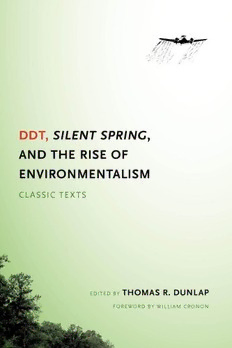
DDT, Silent spring, and the rise of environmentalism: classic texts PDF
Preview DDT, Silent spring, and the rise of environmentalism: classic texts
weyerhaeuser environmental classics william cronon, editor Weyerhaeuser Environmental Classics are reprinted editions ofkey works that explore human relationships with natural environments in all their variety and complexity.Drawn from many disciplines,they examine how natural systems affect human communities,how people affect the environ- ments ofwhich they are a part,and how different cultural conceptions of nature powerfully shape our sense ofthe world around us.These are books about the environment that continue to offer profound insights about the human place in nature. The Great Columbia Plain: A Historical Geography,1805–1910 by D.W.Meinig Mountain Gloom and Mountain Glory: The Development ofthe Aesthetics ofthe Infiniteby Marjorie Hope Nicolson Tutira: The Story ofa New Zealand Sheep Stationby Herbert Guthrie-Smith A Symbol ofWilderness: Echo Park and the American Conservation Movement by Mark Harvey Man and Nature: Or,Physical Geography as Modified by Human Action by George Perkins Marsh;edited and annotated by David Lowenthal Conservation in the Progressive Era: Classic Textsedited by David Stradling DDT,Silent Spring,and the Rise ofEnvironmentalism: Classic Texts edited by Thomas R.Dunlap Weyerhaeuser Environmental Classics is a subseries within Weyerhaeuser Environmental Books,under the general editorship ofWilliam Cronon. A complete listing ofthe series appears at the end ofthis book. DDT, SILENT SPRING, AND THE RISE OF ENVIRONMENTALISM classic texts edited by THOMAS R. DUNLAP foreword by william cronon university of washington press seattle and london DDT,Silent Spring,and the Rise ofEnvironmentalism:Classic Texts is published with the assistance ofa grant from the Weyerhaeuser Environmental Books Endowment,established by the Weyerhaeuser Company Foundation, members ofthe Weyerhaeuser family,and Janet and Jack Creighton. ©2008by the University ofWashington Press Printed in United States ofAmerica Designed by Pamela Canell 14 13 12 11 10 09 5 4 3 2 1 All rights reserved.No part ofthis publication may be reproduced or transmitted in any form or by any means,electronic or mechanical, including photocopy,recording,or any information storage or retrieval system,without permission in writing from the publisher. University ofWashington Press,PO Box 50096,Seattle,WA 98145 www.washington.edu/uwpress Library ofCongress Cataloging-in-Publication Data DDT,Silent Spring,and the rise ofenvironmentalism :classic texts / edited by Thomas R.Dunlap ;foreword by William Cronon. p.cm.— (Weyerhaeuser environmental classics) Includes bibliographical references and index. isbn978-0-295-98834-4(pbk.:alk.paper) 1. DDT (Insecticide)—Environmental aspects—History—20th century. 2. Environmentalism—History—20th century. 3. Nature—Effects ofhuman beings on—History—20th century. 4. Carson,Rachel,1907–1964.Silent spring. I. Dunlap,Thomas R.,1943– td196.p38d45 2009 363.17(cid:2)92—dc22 2008020044 The paper used in this publication is acid-free and 90percent recycled from at least 50percent post-consumer waste.It meets the minimum requirements ofAmerican National Standard for Information Sciences—Permanence of Paper for Printed Library Materials,ansiz39.48–1984.ø Contents Foreword by William Cronon ix Preface and Acknowledgments xi Introduction 3 part 1 BACKGROUND Views ofNature 1 Stephen A.Forbes,“The Ecological Foundations ofApplied Entomology” 15 2 Leland O.Howard,“The War against Insects” 20 Pre-DDT Pesticides and DDT’s Use in World War II 3 Paul Neal et al.,“A Study ofthe Effects ofLead Arsenate Exposure on Orchardists and Consumers ofSprayed Fruit”24 4 Paul Neal et al.,“Toxicity and Potential Dangers of Aerosols,Mists,and Dusting Powders Containing DDT” 26 part 2 DDT’S BRIGHT PROMISE AND NEGLECTED PROBLEMS (1942–1958) DDTas Miracle Chemical 5 Brigadier General James Stevens Simmons,“How Magic is DDT?” 31 6 “Aerosol Insecticides” 39 7 Clay Lyle,“Achievements and Possibilities in Pest Eradication” 44 Early Warnings 8 Paul B.Dunbar,“The Food and Drug Administration Looks at Insecticides” 51 9 Clarence Cottam and Elmer Higgins,“DDTand Its Effect on Fish and Wildlife” 58 part 3 RISING CONCERN ABOUT NEW PROBLEMS DDT,Food Chains,and Wildlife 10 Roy J.Barker,“Notes on Some Ecological Effects ofDDT Sprayed on Elms” 65 11 Editorial from Bird Study 68 12 Derek A.Ratcliffe,“The Status ofthe Peregrine in Great Britain” 70 13 Robert Rudd,Pesticides and the Living Landscape 75 14 Thomas R.Dunlap,Interview with Joseph J.Hickey 80 15 Robert S.Strother,“Backfire in the War against Insects” 85 part 4 THE STORM OVER SILENT SPRING Public Alarm 16 Morton Mintz,“‘Heroine’ofFDAKeeps Bad Drug OffMarket” 94 17 Rachel Carson,“A Fable for Tomorrow” 102 Reactions 18 President’s Science Advisory Committee,Use ofPesticides 104 19 Robert H.White-Stevens,“Communications Create Understanding” 109 20 Edwin Diamond,“The Myth ofthe ‘Pesticide Menace’” 115 21 Robert Gillette,“DDT:Its Days are Numbered,Except Perhaps in Pepper Fields” 121 part 5 DDT AND MALARIA 22 Thomas Sowell,“Intended Consequences” 127 23 Thomas R.Hawkins,“Rereading Silent Spring” 130 24 May Berenbaum,“IfMalaria’s the Problem,DDT’s Not the Only Answer” 136 Notes on Further Reading 141 Credits 145 Index 147 This page intentionally left blank Foreword silent spring and the birth of modern environmentalism william cronon It may be an oversimplification to say that the modern environmental movement began with Rachel Carson’s Silent Spring,but it is hard to overstate that book’s impact.Prior to its publication in 1962,various environmental concerns were becoming more prominent in the years fol- lowing World War II. Air and water pollution, radioactive fallout, toxic exposures,overpopulation,loss ofwild lands,resource scarcities,suburban sprawl:all ofthese were gaining new public attention by the early 1960s,and all would become part ofthe new movement over the course ofthe decade. But Silent Springwas a lightning rod like no other.Gaining visibility first as a series ofarticles in the New Yorkerand then as a best-selling book,it cat- apulted its author—whose earlier writings about the sea had been enor- mously popular but not at all controversial—into a political firestorm.Car- son’s indictment of DDT and other insecticides brought heated rebuttals from chemical companies that manufactured these products, from gov- ernment agencies that promoted their use,and from scientists who believed that their benefits far outweighed their harms.Supportingher were doctors concerned about the medical and genetic consequences oftoxic exposure, biologists who feared the impact ofpesticides on wildlife populations,and parents worried about possible harm to their children.Carson was called before a Senate committee to testify about the book,and President John F. Kennedy was asked about it by the press. CBS News produced a widely ix
